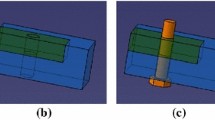Abstract
Interactive assembly based on virtual reality offers users an opportunity to interact with a virtual prototyping rather than a physical one and to validate assembly performance of products in a realistic way. Such evaluations could be available very early in the product development process ahead of any physical prototyping. The reduction or elimination of physical prototyping needed for assembly performance validation can substantially shorten the product development cycle and reduce development cost. Although virtual reality technology provides users an intuitive and immersive 3D interactive interface, it tends to be inaccurate because humans have difficulty in performing precise positioning tasks. Therefore, it is necessary to implement effective motion manipulation for assembly operations so that users can perform precise positioning efficiently in virtual assembly systems. This paper presents a constrained behavior management approach that realizes assembly relationship recognition, constraint solution and constrained motion for interactive assembly in a virtual environment. A constrained behavior manager (CBM) has been developed and applied in virtual assembly systems. Test cases confirm that constrained behavior manipulation proposed in this paper not only increases the efficiency of assembly relationship recognition, but also facilitates assembly interaction in a virtual environment.
Similar content being viewed by others
References
Jayaram S, Jayaram U, Wang Y, Tirumali H, Lyons K, Hart P (1999) VADE: a virtual assembly design environment. IEEE Comput Graph Appl 19(6):44–50
Frohlich B, Tramberend H, Beers A, Agrawala M, Baraff D (2000) Physically-based manipulation on the responsive workbench. Proceedings of IEEE on virtual reality, New Brunswick, NJ, USA, pp 5–11
Bullinger HJ, Richter M, Seidel KA (2000) Virtual assembly planning. Hum Factors Ergon Manuf 10(3):331–341
Banerjee A, Banerjee P (2000) A behavioral scene graph for rule enforcement in interactive virtual assembly sequence planning. Comput Ind 42(2–3):147–157
Yuan X (2000) Interactive assembly planning in virtual environments. Proceedings of 2000 IEEE/RSJ international conference on intelligent robots and systems, Takamatsu, Japan, pp 1462–1467
Srinivasan H, Figueroa R, Gadh R (1999) Selective disassembly for virtual prototyping as applied to de-manufacturing. Robot Comput-Integr Manuf 15(3):231–245
Chryssolouris G, Mavrikios D, Fragos D et al (2000) A virtual reality-based experimentation environment for the verification of human-related factors in assembly processes. Robot Comput-Integr Manuf 16(4):267–276
Rajan VN, Sivasubramanian K, Fernandez JE (1999) Accessibility and ergonomic analysis of assembly product and jig designs. Int J Ind Ergon 23:473–487
Boud AC, Haniff DJ, Baber C, Steiner SJ (1999) Virtual reality and augmented reality as a training tool for assembly tasks. Proceedings of IEEE international conference on information visualization, London, pp 32–36
Kotoku T, Takamune K, Tanie K (1994) A virtual environment display with constraint feeling based on position/force control switching. IEEE international workshop on robot and human communication, Nagoya, Japan, pp 255–260
Ishii M, Sato M (1993) A 3D interface device with force feedback: a virtual workspace for pick-and-place tasks. IEEE virtual reality annual international symposium, Seattle, Washington, pp 331–335
Gupta R, Whitney D, Zeltzer D (1997) Prototyping and design for assembly analysis using multimodal virtual environments. Comput-Aided Des 29(8):585–597
Dewar RG et al (1997) Assembly planning in a virtual environment. Proceedings of the Portland international conference on management and technology (PICMET ’97), Portland, OR, USA, pp 664–667
Gomes de Sá A, Zachmann G (1999) Virtual reality as a tool for verification of assembly and maintenance processes. Comput Graph-UK 23(3):389–403
Fa M, Fernando T, Dew PM (1993) Direct 3D manipulation techniques for interactive constraint-based solid modelling. In: Hubbold RJ, Juan R (eds) Proceedings of eurographics ’93. Blackwell, Oxford, pp C237–C248
Zachmann G, Rettig A (2001) Natural and robust interaction in virtual simulation. In: Proceedings of the 8th ISPE international conference on concurrent engineering, Anaheim, USA
Marcelino L, Murray N, Fernando T (2003) A constraint manager to support virtual maintainability. Comput Graph-UK 27:19–26
Jung B, Latoschik M, Wachsmuth I (1998) Knowledge-based assembly simulation for virtual prototype modeling. Proceedings of the 24th annual conference of the IEEE industrial electronics society IECON’98, vol 4, IEEE, USA, pp 2152–2157
Singh P, Bettig B (2004) Port-compatibility and connectability based assembly design. J Comput Inf Sci Eng 4(3):197–205
Shah JJ, Rogers MT (1993) Assembly modeling as an extension of feature based design. Res Eng Design 3(3/4):218–237
De Fazio TL, Edsall AC, Gustavson RE et al (1993) A prototype of feature-based design for assembly. J Mech Des 115:723–734
Shyamsundar N, Gadh R (2001) Internet-based collaborative product design with assembly features and virtual design spaces. Comput-Aided Des 33:637–651
Kramer GA (1992) Solving geometric constraint system: a case study in kinematics. MIT Press, Cambridge
Author information
Authors and Affiliations
Corresponding author
Rights and permissions
About this article
Cite this article
Liu, Z., Tan, J. Constrained behavior manipulation for interactive assembly in a virtual environment. Int J Adv Manuf Technol 32, 797–810 (2007). https://doi.org/10.1007/s00170-005-0382-5
Received:
Accepted:
Published:
Issue Date:
DOI: https://doi.org/10.1007/s00170-005-0382-5



